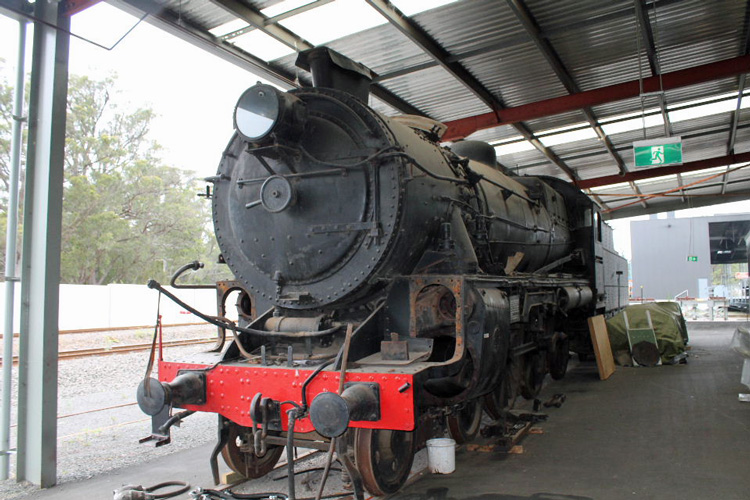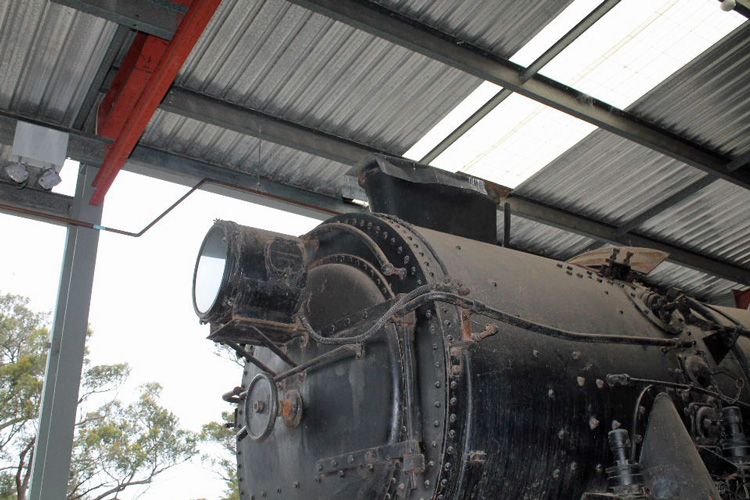|
Successors
to the (C)35 class 4-6-0 on top passenger duties
where the larger and more powerful (C)36 class, designed by New South Wales
Government Railways (NSWGR) under CME E. Lucy for hauling the newly
introduced stock of heavy passenger carriages without resort to
double-heading and with a high capacity tender to allow 100 miles running
without stops for servicing. Passenger
duties on NSWGR main lines called for a large, free steaming boiler to meet
the demands of steep and curvaceous routes, and the (C)36
class were supplied with large round-top boilers at 180 psi together with 23”
diameter pistons and 69” diameter driving wheels producing 30,500 lbs
tractive effort, providing good hill climbing and a fast turn of
speed. Walschaerts (outside) valve
gear was also specified to make lubrication and maintenance easier. Construction was divided between the NSWGR
Eveleigh Workshops (10) and Clyde Engineering Co, Sydney (65).
The
(C)36 class were nicknamed ‘Pigs’ by railwaymen, perhaps
due to the appearance of the large diameter boiler and smokebox. They were superseded on top link passenger
trains by the (C)38 class Pacifics from the late 1940’s
but found further use on secondary passenger and mail duties, together with
some fast freight work. In time the original
round-top boilers became due for renewal and almost all class members were
rebuilt in the mid-1950’s with Belpaire boilers at
200 psi, together with new cabs; as rebuilt the traffic effort increased to
33,880 lbs.
Late
in the steam era the class were being increasingly used for fast freight,
banking and pick-up good services, leading to crew complaints about heavy
reversers, so six class members (3638, 3642, 3644, 3651, 3652 & 3654) were
fitted with power reverse gear salvaged from withdrawn locomotives of other
types. These six were among the final
(C)36’s in revenue service, with 3642 becoming the
last when officially condemned on 28 November 1969 but retained for
historical purposes.
The
authorative ‘Steam Locomotive Data’ (July 1974 edition) provides the
following milestones for loco 3616:
|
In Service:
|
28 February 1927
|
|
Rebuilt
with Belpaire boiler
|
4 November 1953
|
|
Condemned:
|
17 November 1967
|
|
Distance
Travelled:
|
2,799,988
km
|
3616 is one of four
(C)36 class locos (together with 3602, 3615 & 3617) painted in Royal
Blue with yellow and black lining for duties connected with the 1927 Royal
Tour of the Duke and Duchess of York.
However it is better known as the only Australian steam locomotive
fitted with a Giesl ejector which is identifiable by the distinctive
oblong chimney. This drafting
arrangement was fitted as a trial in 1957 and found to improve steaming
& efficiency; 3616 retains this interesting innovation to this
day. However the NSWGR did not fit further
locomotives with the Giesl ejector, presumably due to licence costs and investment
instead being directed towards diesel locomotives.
3616
had been statically restored to lined green livery by NSWRTM volunteers by
the early 1970’s and was displayed in this condition at the original NSWRTM
Enfield Roundhouse museum site. I
believe 3616 may also have done some limited service as a tour loco early
in its preservation career. It was
towed to the new museum site at Thirlmere in 1975 and placed on static
display, however the Thirlmere site originally lacked roof over and 3616’s
livery became faded and rust-streaked.
In 1988 the loco received a quick spray coat of unlined black to
hide this deterioration.
3616
was removed from public display during redevelopment of the Thirlmere
museum to become ‘Trainworks’ and has since been stored undercover near the
workshop area. 3616 still has its
old boiler lagging and I expect this is the reason it is not available for
public display.
From
time to time there has been discussion among NSWRTM volunteers about
returning this loco to service and in recent years some components were
removed as part of an assessment for the likely restoration cost (as seen
in the photos below). In the
meantime, the old boiler lagging would need to be removed by specialist
contractors as the first step to 3616 being returned to static display or for
further restoration; hopefully funding can be found for this purpose in the
near future.
|




